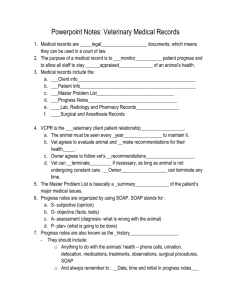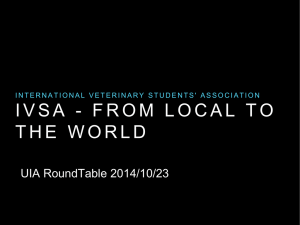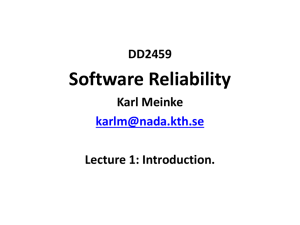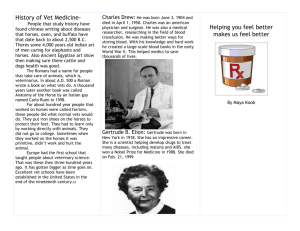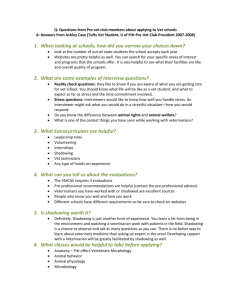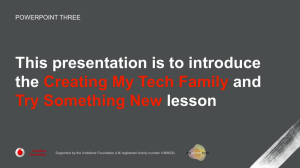14-15 SUT-VET Recommendations
advertisement
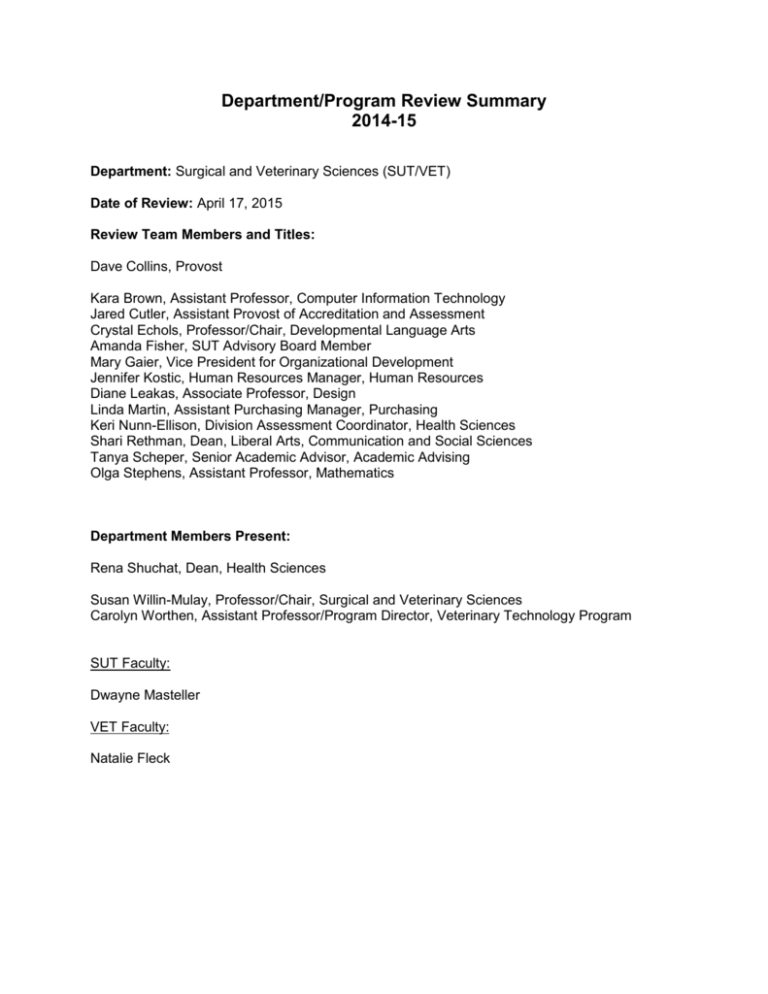
Department/Program Review Summary 2014-15 Department: Surgical and Veterinary Sciences (SUT/VET) Date of Review: April 17, 2015 Review Team Members and Titles: Dave Collins, Provost Kara Brown, Assistant Professor, Computer Information Technology Jared Cutler, Assistant Provost of Accreditation and Assessment Crystal Echols, Professor/Chair, Developmental Language Arts Amanda Fisher, SUT Advisory Board Member Mary Gaier, Vice President for Organizational Development Jennifer Kostic, Human Resources Manager, Human Resources Diane Leakas, Associate Professor, Design Linda Martin, Assistant Purchasing Manager, Purchasing Keri Nunn-Ellison, Division Assessment Coordinator, Health Sciences Shari Rethman, Dean, Liberal Arts, Communication and Social Sciences Tanya Scheper, Senior Academic Advisor, Academic Advising Olga Stephens, Assistant Professor, Mathematics Department Members Present: Rena Shuchat, Dean, Health Sciences Susan Willin-Mulay, Professor/Chair, Surgical and Veterinary Sciences Carolyn Worthen, Assistant Professor/Program Director, Veterinary Technology Program SUT Faculty: Dwayne Masteller VET Faculty: Natalie Fleck COMMENDATIONS: One of the foremost characteristics of the department that stood out to the Review Team is its dedication to its students. That dedication appears to be what motivates this department, and seemed to underlie all aspects of the discussion during the meeting with the Review Team. This is a department that genuinely cares about its students and takes a personal interest in them, even those who are struggling academically. In fact, the department’s concern for students who struggle academically is particularly commendable. For the SUT program, the chair and the faculty can often be found at clinical sites to nurture their students during their practicum experiences, which provides a sharp contrast to students from other institutions at those sites who must try and find their way alone. During the meeting with the Review Team, there were several examples shared of cases where students were struggling in the program and were helped to find a viable direction, or who seemed unprepared academically when they entered the program but were enabled to thrive under with the nurturing approach that the department takes. Maintaining access to the programs by those who may not appear to be academically ready – but who may in fact be very capable of succeeding – is a priority for this department. It is clear that in the SUT and VET programs, the students come first. The department has cultivated and maintained fantastic relationships with the community, and can point to instances where program offerings were developed as a direct result of community requests. Examples of this include the Tissue Banking certificate and the Veterinary Technology Associate of Applied Science program. The department enjoys the support of strong Advisory Groups for both SUT and Vet Tech, and in fact the Vet Tech program owes much to the Advisory Group for laying the foundation that allowed for the initial development of the program. These relationships are strengthened by a strong culture of responsiveness by the department – when a request comes in from the community, the department finds a way to make it happen. The development of the Vet Tech program deserves special commendation – it is a testament to the strong leadership of the chairperson and the program director that the program was planned, implemented, and is functioning so well in a relatively short period of time. The excellent job that was done setting the program up should serve as a model for other departments who seek to establish programs in new areas. As the Vet Tech program sought accreditation, a number of Critical Recommendations and Major Recommendations were made by the accrediting body, and the department quickly and comprehensively addressed each of them. The Review Team was deeply impressed with the way that these recommendations were swiftly addressed in a professional and conscientious manner. This is a department with a “can do!” attitude. Where others might find reasons that something can’t be done, this department is busy finding ways to make it happen. When the possibility of offering a Vet Tech program was first raised in the division, the department chair willingly took the initiative and did what needed to be done to make it happen. The Review Team noted that few complaints were raised by the department during the meeting with them – the culture of this department is focused on solutions and finding ways to make things happen. It is flexible in meeting the needs of its stakeholders, and does so with a positive attitude that speaks well of its faculty. The department’s careful monitoring of the job market, and its efforts to ensure that it isn’t producing more graduates than the job market can absorb, are highly praiseworthy. Many of its competitors are intent on maintaining a high volume of students irrespective of whether jobs will exist for students upon completion – not so with this department, where there are several examples of steps that have been taken to regulate the number of students in the program to align with the number of jobs that will be available. In this, and many other areas, the department acts with integrity, putting the needs of the student first, displaying a forward-thinking approach that takes into account the needs of the students and the community above its own. This department maintains strong relationships with Academic Advising for both the SUT and VET programs. Academic Advisors have described the outreach that the program coordinator for VET made when the program was first being established as an example that should be followed by other departments as they develop new programs. These programs produce highly skilled students who have a reputation for professionalism, and who are preferred by employers over graduates from other area programs. The department can be justifiably proud of the excellent work it does in preparing its students for the workplace. The outcomes for these programs are phenomenal. Trend data from 2002 on in the SUT self-study demonstrated extremely high job placement rates, PAE and CST Exam pass rates, student satisfaction rates, and employer satisfaction rates. The Vet Tech program can boast a 100% placement rate for its first groups of graduates. By any measure, these are programs that successfully prepares graduates. This department displays excellent stewardship of resources, working to keep costs low. For example, the SUT program received donated consumable supplies from area operating room departments to help keep costs down. This conscientious approach to fiscal management is particularly important – and appreciated – in the leaner budgetary environment that the College currently finds itself in. The mission statements of these departments display a clear sense of their place in the community and the important role that they serve. They know who they are and what their purpose is, which gives a sense of focus to direction that the department pursues. The Review Team was particularly impressed with the warm, inclusive language found in the Vet Tech mission statement, which speaks of “individuals who want to become skilled and compassionate members of the veterinary medical community” learning “the importance of the human-animal bond.” RECOMMENDATIONS FOR ACTION: This is a dynamic department with a positive attitude and a high capacity for meeting stakeholder needs – how can this be modeled for other departments? It may be that workshops and presentations regarding the work of the department could help pass some of this positivity on to other departments. Specifically, the department is encouraged to develop a presentation on developing and implementing new programs, since the Vet Tech program is such an excellent example of how this can be done right. In many ways the assessment work that the department performs is very impressive – rubrics are used to assess program outcomes and General Education outcomes, and this data is supported by employer data that echoes the high level of achievement of its students. However, many of the assessment results show students achieving 100% levels, and while this indicates an extremely high level of achievement in terms of students meeting the outcomes, it provides limited data regarding where improvements can be made. The Review Team recommends that the department find ways to dig deeper into its assessment data to identify actionable improvements. This is clearly a high functioning department that does a stellar job of preparing its students to meet program outcomes – however, it may be that fine tuning the assessments would allow the department to collect actionable data that could lead to improvements. The Review Team recommends working with the Divisional Assessment Coordinator, who is a valuable resource for improving assessment practice. The department should not think that the Review Team finds its assessment work lacking – on the contrary, it is impressive. The Review Team is simply suggesting that even with an impressive assessment program there may be an opportunity to collect additional assessment data that could lead to program improvement. The department noted the growing challenge of finding practicum placements for all of its graduates, and during the meeting with the Review Team the dean expressed an interest in helping to nurture relationships with practicum sites. The department is strongly encouraged to work with the dean’s office and secure their support in bringing about greater involvement in maintaining and enhancing relationships with practicum sites. As is the case for many Health Sciences departments diversity of students and faculty remains an issue. The department is strongly encouraged to explore ways of increasing diversity, particularly in terms of recruitment in areas with a high population of potential minority students. The department is also encouraged to seek out information on programs that might help them increase diversity. The department expressed a desire to develop a Vet Tech certificate program for students who were previously or are currently incarcerated – the Review Team strongly recommends that the department explore this possibility. In doing so, the department should consider parameters and roadblocks, and determine what the limitations for this population might be in terms of future employment. It may be that the development of a less technical certificate may be warranted. Along those lines, a less technical Veterinary-related certificate may be of benefit to students who struggle academically in the current programs. The department should consider possibilities in light of occupational opportunities for students who earn a less technical certificate in this area. The SUT program noted that a BIO 2205 prerequisite has been implemented – the department should carefully consider the possible impacts of this change based on available data. The Review Team recommends that the department meet with the Dean and the Division Assessment Coordinator to discuss possible impacts of this change, and whether it is supported by the available data. The VET program discussed at length the benefits it has seen from the Introduction to Animal Sciences course. Should SUT consider offering a similar introductory course? The department is encouraged to have discussions weighing the pros and cons of such a course. The Health Sciences Strategy that Sinclair is developing and will soon be implementing calls for inter-professional strategies that acclimate students to working in teams with professionals from other disciplines. The SUT program lends itself well to these kinds of arrangements – the department is encouraged to consider how the Vet Tech program might also be incorporated into these inter-professional approaches. The SUT program has set goals for developing three programs: full implementation of the Sterilization Processing Technician short-term certificate, the Perioperative Nursing short-term certificate, and the Surgical First Assisting Program, some of which are slated for within the next few terms. The departments should consider whether the staffing requirements of full implementation of these programs might be prohibitive, and whether additional efforts at recruiting and training adjunct faculty might be required. OVERALL ASSESSMENT OF DEPARTMENT’S PROGRESS AND GOALS: What an impressive department! The Review Team was unanimous in its praise of what the department is doing, and found much to commend in the self-studies and meeting. It is a remarkably cohesive department, especially given that it has recently developed a new program that is considerably different than its traditional program offerings. This development of the Vet Tech program has not lead to a divergence that would lead the department in two conflicting directions, potentially causing a rift – rather there is a surprising amount of cohesion between these two very different areas housed in the same department. There were some questions among Review Team members about how well the meeting with the Review Team would flow with two separate self-studies being reviewed – and it was surprising to see how naturally the conversation shifted from SUT to Vet Tech and back again, with a very easy flow of discussion between the two areas. Strong leadership, supportive faculty, and a positive, optimistic culture no doubt have much to do with this sense of cohesion. The Surgical Technology program has traditionally been strong, and by itself would merit much praise. This already impressive department also managed to get a new Vet Tech program up and running in a relatively small amount of time in a smooth, non-disruptive, professional manner, quickly and competently addressing issues raised by the accrediting body. In the meeting with the Review Team, the department evidenced an above average commitment to its students, and an extremely laudable dedication to allowing every student a chance to succeed, even when past academic performance did not make that seem likely. Many students have benefitted from this drive to ensure that every student gets a chance. Access has always been a foundational value of Sinclair – this department exemplifies commitment to access at a level that few other departments at Sinclair can touch, changing the lives of students who might not have had a chance to succeed in other programs. INSTITUTIONAL OR RESOURCE BARRIERS TO THE DEPARMTENT’S ABILITY TO ACCOMPLISH ITS GOALS, IF ANY: Adjunct support is a challenge for many departments at Sinclair – this is small, close-knit department that typically recruits its own adjunct applicants. Is it possible that this may be somewhat hindering the ability of the department to increase ethnic diversity in its instructors? How can instructors with more diverse backgrounds be recruited in small departments such as this one? The department was commended for its “can do” attitude and willingness to take on new challenges without complaint – it truly exemplifies “find the need and endeavor to meet it.” How can this be held up as a model for other departments? What can be done to spread this attitude across campus? The new Health Sciences strategy will dramatically impact the space and resources devoted to this department, along with many others on campus. As space is allocated through this initiative this department will want to be sure it is part of the conversation. Inter-professional collaboration between Health Sciences programs is key to the new Health Sciences strategy – should all Health Sciences programs be required to address this as part of their Program Review goals for the next five years? It is easy to see how this might be implemented for SUT, but what ways could Vet Tech find to collaborate with other Health Sciences programs in training their students?

